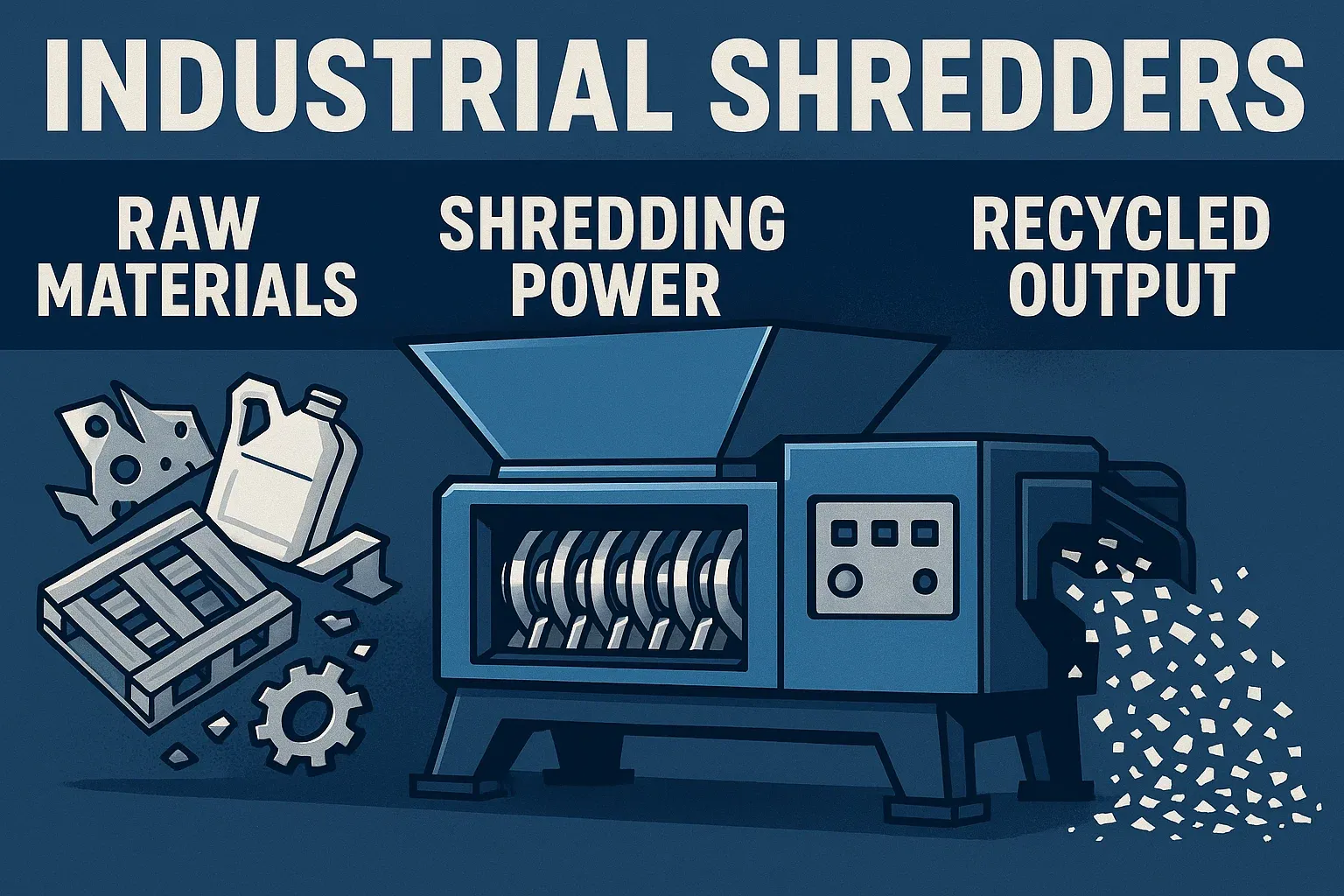¿Qué es una trituradora industrial?
Una trituradora industrial es una máquina potente diseñada específicamente para triturar materiales grandes, duros o mixtos en trozos más pequeños y manejables. Estas trituradoras procesan artículos voluminosos y residuos difíciles, lo que facilita el procesamiento, el reciclaje y la gestión de los residuos. Generalmente, las trituradoras industriales son el primer paso en el tratamiento de residuos y reducen significativamente el volumen de los mismos, protegiendo así los equipos utilizados en etapas posteriores del procesamiento.
¿Cómo funciona una trituradora industrial?
1. Operación principal: baja velocidad, alto par
La mayoría de las trituradoras industriales funcionan a bajas velocidades de rotación (entre 3,6 RPM y aproximadamente 130 RPM), pero generan un par motor extremadamente alto. Esta combinación permite a las trituradoras desgarrar, cizallar o triturar materiales resistentes e impredecibles con eficacia. A diferencia del corte de precisión, las trituradoras se basan en la fuerza bruta para manipular diversos materiales, como residuos sólidos urbanos y escombros de construcción. El alto par motor evita atascos y paradas, lo que permite un funcionamiento continuo, mientras que la baja velocidad ayuda a las cortadoras a sujetar y procesar los materiales sin romperlos, lo que las hace ideales para el procesamiento inicial de residuos.
2. Componentes clave
Las trituradoras industriales tienen varios componentes robustos:
- Rotores y cortadores: Rotores de alta resistencia equipados con cuchillas, ganchos o cuchillas resistentes fabricados con materiales resistentes al desgaste, como acero para matrices de trabajo en frío.
- Cámara de corte: Un recinto fuertemente reforzado donde se produce la trituración, diseñado para soportar fuerzas mecánicas intensas.
- Pantallas (opcional): Algunas trituradoras incorporan cribas debajo de los rotores para controlar el tamaño máximo de las partículas (normalmente de 20 mm a 100 mm). Estas cribas ayudan a gestionar el tamaño de las partículas para su posterior manipulación, aunque no generan partículas muy uniformes.
- Ariete hidráulico (opcional): Las trituradoras de un solo eje a menudo incluyen un cilindro hidráulico para empujar los materiales horizontalmente hacia el área de corte, lo que mejora la eficiencia del procesamiento de materiales voluminosos o livianos.
- Sistemas de accionamiento y control: Motores potentes, reductores de engranajes y sistemas de control eléctrico centrados en la seguridad garantizan un funcionamiento seguro y eficiente.
3. Tipos de trituradoras industriales
Las trituradoras vienen en varias variedades, cada una adecuada para tareas específicas:
- Trituradoras de un solo eje: Un rotor con cortadores giratorios contra cuchillas estacionarias, que proporciona un tamaño de partícula relativamente consistente a través de una pantalla integrada.
-
Trituradoras de múltiples ejes:
- Trituradoras de doble eje (de cizalla): Dos ejes contrarrotativos tiran y cortan los materiales en tiras, ideal para artículos voluminosos.
- Trituradoras de cuatro ejes: Cuatro ejes que proporcionan una trituración agresiva, dando como resultado piezas más pequeñas y uniformes en una sola pasada.
- Trituradoras de perforación y desgarro: Equipados con ejes de movimiento lento y cuchillas en forma de gancho, trituran eficazmente materiales resistentes y de formas irregulares.
- Muelas: Ejes o tambores giratorios de alta velocidad equipados con cuchillas o martillos para corte y triturado combinados, adecuados para plásticos, madera y materiales orgánicos.
-
Trituradoras especializadas:
- Trituradoras de tambor: Utilice tambores giratorios con cuchillas o martillos para el procesamiento de grandes volúmenes de residuos orgánicos y madera.
- Trituradoras: Diseñados específicamente para desechos de jardín, cortan rápidamente ramas y madera en pequeñas astillas.
- Molinos de martillos: Utilice martillos oscilantes que giren rápidamente para pulverizar materiales en partículas más finas.
Características del material triturado
El material producido por las trituradoras generalmente incluye:
- Grande, tamaño variable: El rango es amplio, desde 20 mm a 100 mm o más, a diferencia de los granuladores, que producen partículas más pequeñas y uniformes.
- Forma irregular: El resultado suele consistir en tiras irregulares, trozos o piezas ásperas, reflejo del método de trituración agresivo.
- Baja uniformidad: Los materiales triturados varían mucho en tamaño y forma, a menudo incluyen polvo y partículas finas y generalmente requieren un procesamiento adicional para un uso con precisión.
Materiales y aplicaciones
Materiales típicamente procesados:
Las trituradoras industriales manejan diversos materiales, entre ellos:
- Llantas
- Metales (aluminio, cobre, latón)
- escombros de construcción
- Madera (palets, troncos)
- Plásticos (bidones, tuberías)
- Residuos electrónicos (e-waste)
- Papel y cartón
- Textiles y cuero
- Residuos alimentarios y farmacéuticos
- Muebles y caucho
- Dispositivos de almacenamiento de datos (discos duros)
Aplicaciones comunes:
Las trituradoras industriales se utilizan principalmente para:
- Reducción de volumen: Reducción de residuos voluminosos para un manejo más sencillo y un transporte rentable.
- Reciclaje inicial: Preparar materiales descomponiéndolos para facilitar su clasificación y reciclaje.
- Destrucción segura: Destrucción segura de documentos confidenciales, productos defectuosos o dispositivos de datos.
- Tratamiento de residuos: Procesamiento de diversos tipos de residuos (municipales, médicos, peligrosos) antes de su eliminación o tratamiento posterior.
- Recuperación de recursos: Extracción de materiales valiosos como metales de los residuos electrónicos o caucho de los neumáticos.
Las trituradoras industriales, por su versatilidad, confiabilidad y resistencia, se han vuelto indispensables en la gestión de residuos, el reciclaje y la recuperación de recursos, mejorando significativamente la sostenibilidad ambiental y la eficiencia operativa.



